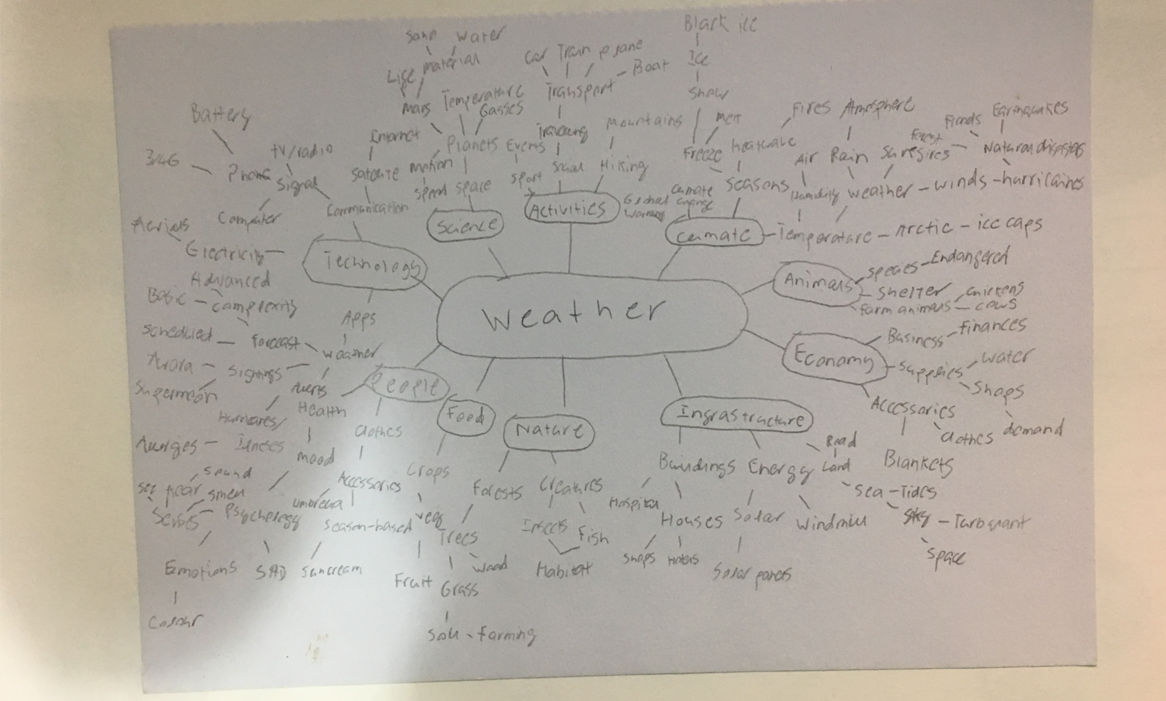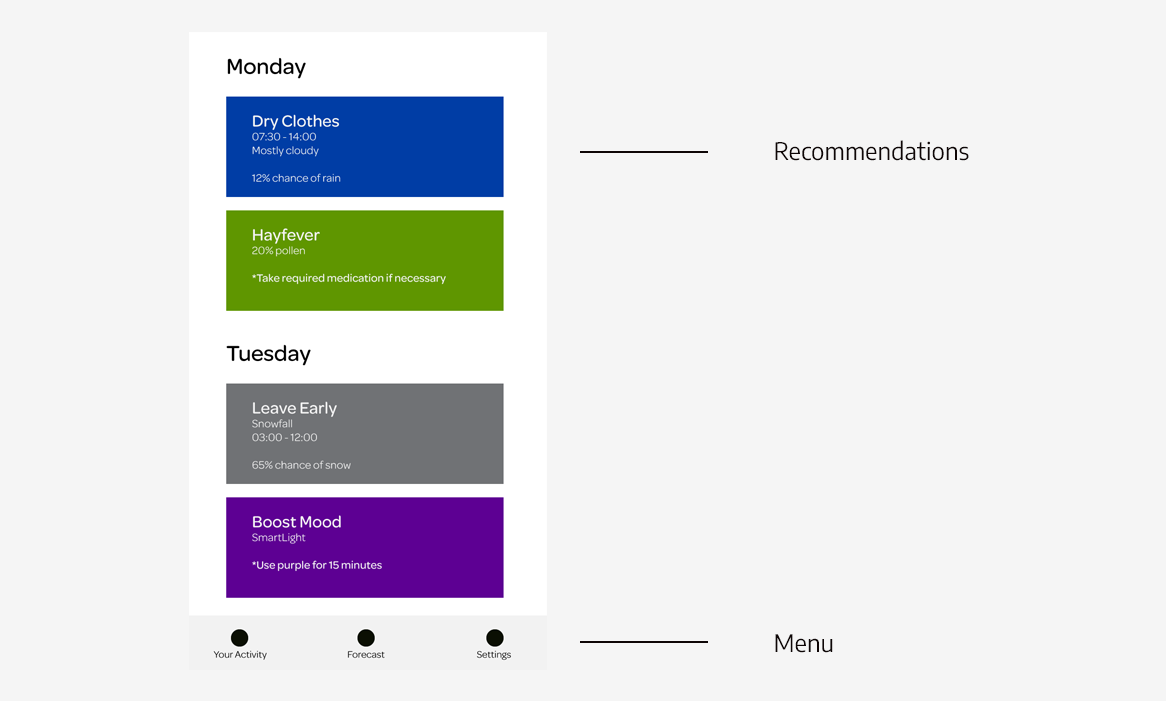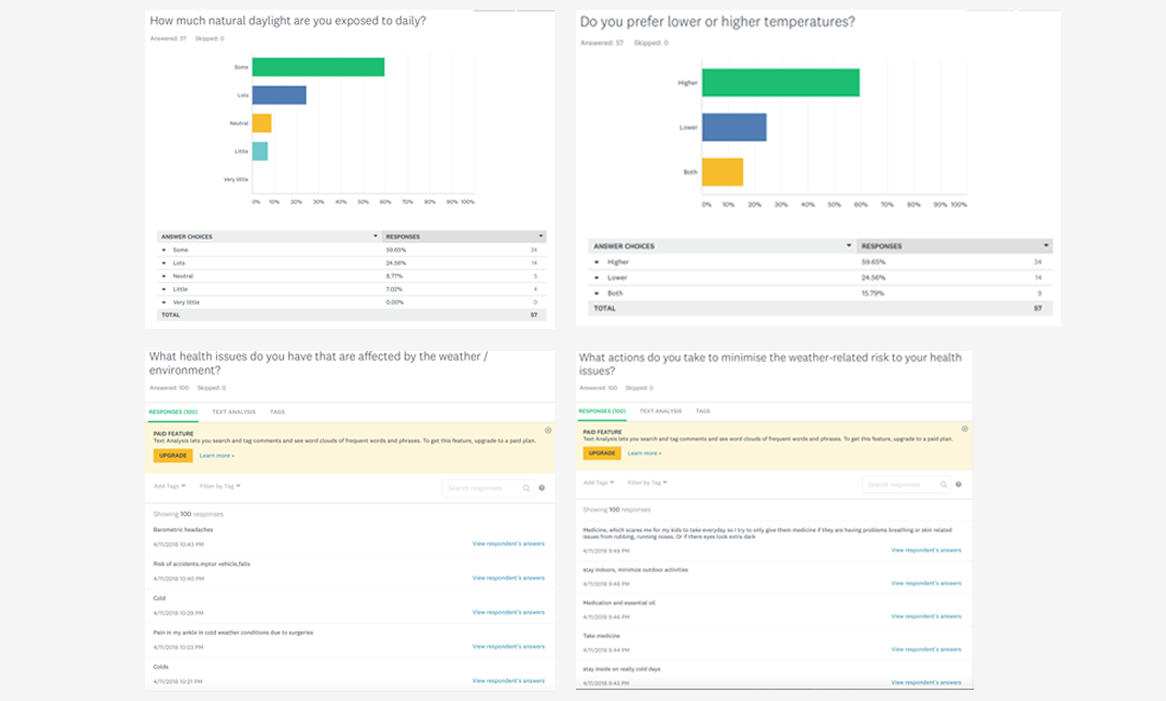
There are many types of weather apps out there: Basic ones, quirky ones, specific ones such as tracking the wind or rare sights such as auroras. With so many different subgenres of weather apps out there, the potential to create something that hasn’t been done before is getting smaller and smaller. I was tasked with the challenge of creating a new idea for a weather app that was different and unique. This would need to be targeted towards a specific subject that is affected by the weather and the environment. With this in mind it would also need to target a specific audience rather than just your casual weather app user. A difficult challenge in the current market.

When trying to essentially come up with a niche idea for a weather app, the first two steps I felt were the most important was to work on some brainstorming, just to think of some general ideas and see if there’s any ideas that initially interested me, then would do some research to see what was out there already and also, see what wasn’t there. I categorized the apps I could find, there were environmental apps, ones for forecasts, activities, science, navigation and health. This helped give me a base as to what types of weather-related apps are already out there. At this point I continued brainstorming out some ideas to see if I could think of anything that looked unique in comparison to the types of apps already created. From the start the thing that piqued my interest was the aspect of health and how the weather affects that.
I tried randomly choosing three words from my brainstorming exercise to see if I could think of anything from them, but I wasn’t particularly convinced with what I had. Looking around at ideas, it suddenly came to me about the concept of weather and solar energy, which made me think I had my eureka moment. I was researching about solar panels and how they work. When looking for apps related to this, there wasn’t really that much around, which on one side is great because you think you’ve found a niche, but on the other hand there’s no real guidance as to how you could make that work on an app, which ultimately found off-putting.

I went back to the drawing board and tried to look closer to home (the subject). I suddenly thought of the sentence ‘keep ahead of the weather’. This interested me and started thinking of ideas on how to help people stay ahead of conditions. I was thinking of ideas such as allowing users to pay for related products within a weather forecast app – based on the weather, and so on. I felt this was branching out too much and then thought of an app that gives recommendations on daily activities based on the forecast, such as drive to work earlier if conditions are bad, and so on. Part of that included recommendations for health, at that point it seemed like I had gone full circle. I was interested in weather and health, I wanted to keep it as close to weather as possible; and then the idea came to me: an app which gives you recommendations for your health issues that are affected by the weather.
“I was interested in weather and health, I wanted to keep it as close to weather as possible.”
I had looked around at medical apps but hadn’t found one that really matched my idea. With this being the case I decided to go ahead with the idea.I designed a couple of surveys to try and get as much information and potential connections as possible. Whilst finding out about them with specific personal questions and ones related to weather, where they live, their personality and how the weather affects them. The second survey was about finding out what weather-related medical issues people had and how they coped. After compiling all the information together, I felt it was time to start working on the contents of the app itself.

Once I put the information from the survey’s together, not only did it validate my idea, but it also gave me an understanding of the type of audience who’d be interested in it. From the responses I received in the survey, I was able to categorise the weather-related health conditions into the following: Breathing (asthma, lungs, sinus), immune system (colds, infections), irritations (eczema, hay fever), mental health (depression, S.A.D.) and pains (arthritis, circulation, fibromyalgia, headaches). Other information I gathered from the surveys was the type of content the users’ would want from such an app. This included daily advice, accurate weather updates, the capability to track specific environmental aspects which affect their health and the ability to track their own progress. For an app that is designed to help you cope with weather-related health issues, these features make sense; thus, these are the features we would work with. We gathered the types of people who would want the app as well, these included 18-24 year-old females, 25-34 year-old males and females, 35-44 year-old females, 55-64 year-old females, 65-74 year-old males and 75+ year-old males and females. These are valuable for creating user personas, which give you a template for the type of customer you are creating the app for. With a diverse range of ages involved, it was important to make the look and feel of the app be appropriate for all.
It was decided that a dark blue and turquoise colour scheme would be appropriate, representing the environmental side of the app and also the health aspect; with this in mind it was also decided that the app should be named ClimaHealth, again, pointing to the environment and the medical aspect. The user journey map was worked on to work out the best process for the user to use the app effectively and smoothly. The process goes as: Start up / log in / sign up stage > set up / create account > onboarding screens > Main app: Hub (recommendations) screen > symptom tracker > weather forecast > threat graph > profile section. As for the main sections of the app, the hub screen is meant to give you daily recommendations as to how to protect yourself from your weather-inflicting health conditions. For instance, if you suffer from hay fever, you’ll be recommended to avoid flowery areas or take certain medication, even to avoid going out at a certain time. The medical tracker is designed to show you your progress throughout the month, with progress bars to illustrate whether your health has improved, remained the same or deteriorated since taking the advice of the app. The weather forecast section simply illustrates what the weather will be like for the week ahead. The threat graph, for instance will visually show how high or low the amount of pollen will be during the week ahead, if pollen is a key source to your health issue.
When you are starting off, you don’t have real understanding of the work that is put into creating professional, and convenient products / services. You begin with the mindset that you think you know what other people want and that they will like it. That couldn’t be any further from the truth. User experience practices are absolutely critical to gaining an understanding of your potential target audience, what their problems are and what they think they would like. You can’t collect enough information from people / potential customers and that’s when UX practices show their importance. Creating user personas are critical for molding a potentially ideal customer(s). Mapping out their pain points and desires are valuable for working on the features of the product, which of course then becomes useful for creating customer journey maps.
This is just a simplified way of explaining some of the steps required to creating an app and an experience that gives the users what they want. Obviously, you have to factor in business goals for the company and that can have an effect on what is / isn’t, can / can’t be done, and balancing the two is the main objective. I have really come to appreciate the value of user experience practices, such as agile design methods and the tasks involved within them. In future, I hope to experience the process and improve my effectiveness in the field and overall feel it has opened my eyes as to what is required to deliver a potentially successful service / product.